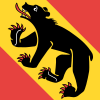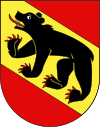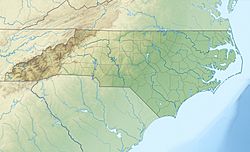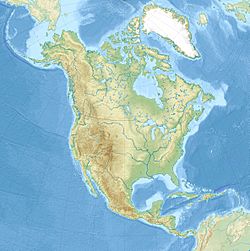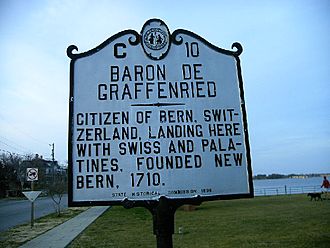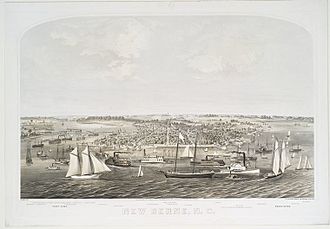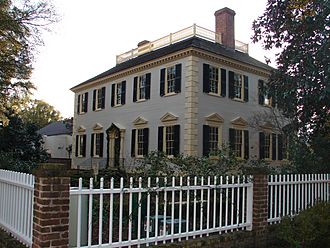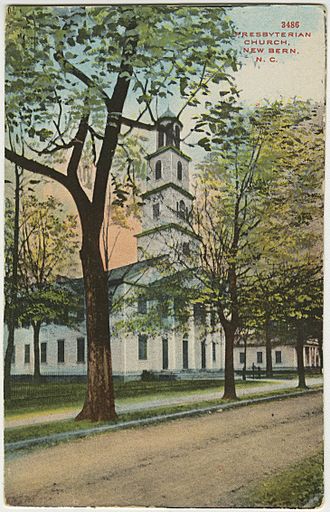New Bern, North Carolina facts for kids
Quick facts for kids
New Bern, North Carolina
|
|||
|---|---|---|---|
| City of New Bern | |||
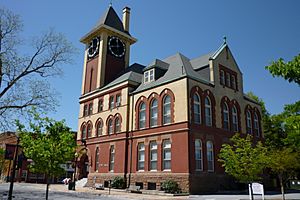
Main façade of the New Bern City Hall
|
|||
|
|||
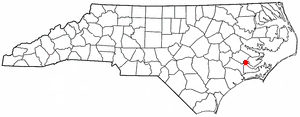
Location in Craven county and the state of North Carolina
|
|||
| Country | |||
| State | |||
| County | Craven | ||
| Founded | October 1710 | ||
| Chartered | November 23, 1723 | ||
| Founded by | Baron of Bernberg | ||
| Named for | Bern, Switzerland | ||
| Government | |||
| • Type | Council–Manager | ||
| Area | |||
| • Total | 29.77 sq mi (77.10 km2) | ||
| • Land | 28.28 sq mi (73.25 km2) | ||
| • Water | 1.49 sq mi (3.85 km2) | ||
| Elevation | 10 ft (3 m) | ||
| Population
(2020)
|
|||
| • Total | 31,291 | ||
| • Density | 1,106.39/sq mi (427.18/km2) | ||
| Time zone | UTC-5 (Eastern (EST)) | ||
| • Summer (DST) | UTC-4 (EDT) | ||
| ZIP codes |
28560, 28562
|
||
| Area code(s) | 252 | ||
| FIPS code | 37-46340 | ||
| GNIS feature ID | 1013911 | ||
New Bern, formerly called Newbern, is a city in Craven County, North Carolina, United States. As of the 2010 census it had a population of 29,524, which had risen to an estimated 29,994 as of 2019. It is the county seat of Craven County and the principal city of the New Bern Metropolitan Statistical Area.
It is located at the confluence of the Neuse and the Trent rivers, near the North Carolina coast. It lies 112 miles (180 km) east of Raleigh, 80 miles (130 km) north of Wilmington, and 162 miles (261 km) south of Norfolk. New Bern is the birthplace of Pepsi.
New Bern was founded in October 1710 by the Palatines and Swiss under the leadership of Christoph von Graffenried. The new colonists named their settlement after Bern, the Swiss region from which many of the colonists and their patron had emigrated. The flag and arms of the American city are virtually identical to those of the Swiss canton. The English connection with Switzerland had been established by some Marian exiles who sought refuge in Protestant parts of Switzerland. There were also marriages between the House of Stuart and notable people in the history of Calvinism. The colonists later discovered they had started their settlement on the site of a former Tuscarora village named Chattoka. This caused conflicts with the Tuscaroras who were in the area.
New Bern is the second-oldest European settled colonial town in North Carolina, after Bath. It served as the capital of North Carolina from 1770 to 1792. After the American Revolution (1775–1783), New Bern became wealthy and quickly developed a rich cultural life. At one time New Bern was called "the Athens of the South," renowned for its Masonic Temple and Athens Theater. These are both still very active today.
New Bern has four historic districts listed on the National Register of Historic Places; their numerous contributing buildings include residences, stores and churches dating back to the early eighteenth century. Within walking distance of the waterfront are more than 164 homes and buildings listed on the National Register. Also nearby are several bed and breakfasts, hotels, restaurants, banks, antiques stores and specialty shops. The historic districts contain many of the city's 2,000 crape myrtles—its official flower—and developed gardens. New Bern has two "Local Historic Districts", a municipal zoning overlay that affords legal protection to the exteriors of New Bern's historic structures.
Contents
History

Varying complex cultures of indigenous peoples had lived along the waterways of North Carolina for thousands of years before Europeans explored the area. The Tuscarora, an Iroquoian-speaking people, had migrated south from the Great Lakes area in some ancient time and occupied this area for hundreds of years before any Europeans arrived. They had an ancient village, Chattoka, here at the confluence of the rivers. They resisted encroachment by the Europeans, rising up in resistance in 1712.
New Bern was first settled by Europeans in 1710 by Swiss and Palatine German immigrants under the leadership of Christoph von Graffenried, Franz Louis Michel and John Lawson. They named the settlement after Bern, von Graffenried's home town that would later become the capital of Switzerland. Von Graffenried had the original plat of the town laid out in the shape of a cross, though later development and additional streets have obscured this pattern within the regular street grid. This became the first permanent seat of the colonial government of North Carolina.
Tryon Palace was completed in 1770 as the British colonial government house. After the Revolution, New Bern became the state capital. Tryon Palace was used for the state government. The Palace burned in the 1790s.
During the 19th-century Federal period, New Bern became the largest city in North Carolina, developed on the trade of goods and slaves associated with plantation agriculture. After Raleigh was named the state capital, New Bern rebuilt its economy by expanding on trade via shipping routes to the Caribbean and New England. It was part of the Triangle Trade in sugar, slaves and desired goods. It reached a population of 3,600 in 1815.
In 1862 during the early stages of the Civil War, the area was the site of the Battle of New Bern. Union forces captured and occupied the town until the end of the war in 1865. Nearly 10,000 enslaved blacks escaped during this period in the region and went to the Union camps for protection and freedom. The Union Army set up the Trent River contraband camp at New Bern to house the refugees. It organized the adults for work. Missionaries came to teach literacy to both adults and children.
After the January 1863 Emancipation Proclamation of President Abraham Lincoln, slaves in Union-occupied territories were declared free; more freedmen came to the Trent River camp for protection. The Army appointed Horace James, a Congregational chaplain from Massachusetts, as the "Superintendent of Negro Affairs for the North Carolina District." In addition to the Trent River camp, James supervised development of the offshore Roanoke Island Freedmen's Colony, which was intended to be self-supporting. Beginning in 1863, a total of nearly 4,000 freedmen from North Carolina enlisted in the United States Colored Troops to fight with the Union for their permanent freedom, including 150 men from the colony on Roanoke Island.
Due to the continuous occupation by the Union troops, New Bern avoided some of the destruction of the war years. There was much social disruption because of the occupation and the thousands of freedmen camped near the city. Still, it recovered more quickly than many cities after the war.
By the 1870s the lumber industry was developing as the chief part of New Bern's economy. Timber harvested could be sent downriver by the two nearby rivers. The city continued to be a center for freedmen, who created communities independent of white supervision: thriving churches, fraternal associations, and their own businesses. By 1877 the city had a majority-black population.
The state legislature defined the city and county as part of North Carolina's 2nd congressional district which, as former plantation territory, held a concentration of the state's black residents. They elected four blacks to the US Congress in the late 19th century. The state's passage of a constitutional suffrage amendment in 1900 used various devices to disenfranchise black citizens. As a result, they were totally closed out of the political process, including participation on juries and in local offices; white Democrats maintained this suppression mostly, until after passage of federal civil rights legislation, including the Voting Rights Act of 1965, which provided for federal enforcement of constitutional rights.
By 1890 New Bern had become the largest lumber center in North Carolina and one of the largest in all of the South. During this time, as many as 16 lumber mills were running and employing hundreds of men from New Bern and the area. The competitive nature of the lumber barons, the abundance of lumber and craftsmen, led to the construction in New Bern of some of the finest homes in the South, many of which have survived. The lumber boom lasted until the 1920s. One by one the lumber mills went out of business. Today only Weyerhaeuser manufactures lumber in the area.
The city has four National Historic Districts and two local ones, which have helped preserve the character of the architecture. The Downtown Local Historic District is 368.64 acres (149.18 ha) or 0.576 square miles (1.49 km2); the Riverside Local Historic District covers 51.94 acres (21.02 ha) or 0.081 square miles (0.21 km2).
Union Point Park borders the Neuse and Trent rivers. It is the site of the city's major celebrations, such as Neuse River Days and the Fourth of July. Since 1979 the Swiss Bear Downtown Revitalization Corporation has worked to redevelop downtown; it has stimulated the creation of art galleries, specialty shops, antiques stores, restaurants and inns. This area has become a social and cultural hub. James Reed Lane is a downtown mini-park and pedestrian walk-through on Pollock Street across from historic Christ Church. Private restoration efforts have returned many of the downtown buildings to their turn-of-the-twentieth-century elegance.
In 2005, a segment of NBC's The Today Show noted that New Bern was one of the best places in the United States to retire. Retirees from the northern states have added to its population.
The Attmore-Oliver House, J.T. Barber School, Baxter Clock, Bellair, Blades House, Bryan House and Office, Cedar Grove Cemetery, Cedar Street Recreation Center, Centenary Methodist Church, Central Elementary School, Christ Episcopal Church and Parish House, Coor-Bishop House, Coor-Gaston House, Craven Terrace, DeGraffenried Park Historic District, Ebenezer Presbyterian Church, First Baptist Church, First Church of Christ, Scientist, First Missionary Baptist Church, First Presbyterian Church and Churchyard, Ghent Historic District, Gull Harbor, Harvey Mansion, Hawks House, William Hollister House, Thomas Jerkins House, Jerkins-Duffy House, Jones-Jarvis House, Ulysses S. Mace House, Masonic Temple and Theater, Mount Shiloh Missionary Baptist Church, New Bern Battlefield Site, New Bern Historic District, New Bern Municipal Building, New Bern National Cemetery, Rhem-Waldrop House, Riverside Historic District, Rue Chapel AME Church, Slover-Bradham House, Eli Smallwood House, Isaac H. Smith, Jr., House, Benjamin Smith House, Smith-Whitford House, St. John's Missionary Baptist Church, St. Paul's Roman Catholic Church, St. Peter's AME Zion Church, Edward R. Stanly House, John Wright Stanly House, Stevenson House, Isaac Taylor House, Tisdale-Jones House, and York-Gordon House are listed on the National Register of Historic Places.
Geography
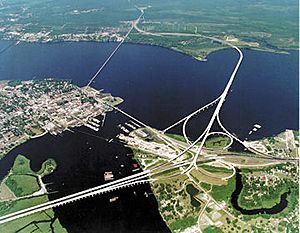
New Bern is located in the center of Craven County at 35°6′33″N 77°4′9″W / 35.10917°N 77.06917°W (35.109070, −77.069111). It is sited at the junction of the Trent and Neuse rivers, two tidal waterways.
U.S. Route 70 and U.S. Route 17 pass through the city, merging briefly as a four-lane expressway passing south of the city center. US 70 leads west 33 miles (53 km) to Kinston and southeast 35 miles (56 km) to Morehead City near the Atlantic Ocean. Raleigh, the state capital, is 112 miles (180 km) west via US 70. US 17 leads southwest 37 miles (60 km) to Jacksonville, North Carolina, and crosses the Neuse River on a new bridge to lead north 36 miles (58 km) to Washington, North Carolina.
New Bern is located in North Carolina's Inner Banks region. According to the United States Census Bureau, the city has a total area of 29.7 square miles (76.9 km2), of which 28.2 square miles (73.1 km2) is land and 1.4 square miles (3.7 km2), or 4.87%, is water.
Climate
New Bern experiences a humid subtropical climate typical of the Atlantic coastal plain. Summers are hot and humid, with frequent afternoon thunderstorms that account for much of the higher summer precipitation. Spring and fall are generally mild, with fall foliage occurring from late October to early November. Winters are relatively mild and dryer than the remainder of the year, with infrequent snowfall.
| Climate data for New Bern, North Carolina | |||||||||||||
|---|---|---|---|---|---|---|---|---|---|---|---|---|---|
| Month | Jan | Feb | Mar | Apr | May | Jun | Jul | Aug | Sep | Oct | Nov | Dec | Year |
| Record high °F (°C) | 81 (27) |
88 (31) |
90 (32) |
95 (35) |
100 (38) |
105 (41) |
106 (41) |
103 (39) |
101 (38) |
97 (36) |
87 (31) |
83 (28) |
106 (41) |
| Average high °F (°C) | 55 (13) |
58 (14) |
65 (18) |
74 (23) |
80 (27) |
87 (31) |
90 (32) |
88 (31) |
83 (28) |
75 (24) |
66 (19) |
58 (14) |
73 (23) |
| Average low °F (°C) | 34 (1) |
36 (2) |
42 (6) |
50 (10) |
59 (15) |
68 (20) |
72 (22) |
70 (21) |
65 (18) |
54 (12) |
44 (7) |
36 (2) |
53 (12) |
| Record low °F (°C) | 1 (−17) |
6 (−14) |
17 (−8) |
29 (−2) |
32 (0) |
44 (7) |
55 (13) |
50 (10) |
43 (6) |
26 (−3) |
17 (−8) |
−4 (−20) |
−4 (−20) |
| Average rainfall inches (mm) | 4.77 (121) |
3.80 (97) |
4.49 (114) |
3.40 (86) |
4.19 (106) |
4.80 (122) |
6.48 (165) |
6.84 (174) |
5.45 (138) |
3.39 (86) |
3.23 (82) |
3.84 (98) |
54.68 (1,389) |
| Average snowfall inches (cm) | 1.0 (2.5) |
0.8 (2.0) |
0.5 (1.3) |
0.1 (0.25) |
0 (0) |
0 (0) |
0 (0) |
0 (0) |
0 (0) |
0 (0) |
0.1 (0.25) |
0.2 (0.51) |
2.7 (6.9) |
| Source 1: National Weather Service | |||||||||||||
| Source 2: Weatherbase | |||||||||||||
Transportation
Coastal Carolina Regional Airport is a public airport located 3 miles (5 km) south of the central business district of New Bern. The airport offers connecting flights to the Atlanta and Charlotte airports daily.
The New Bern Transport Corporation, a business entity owned by PepsiCo to manage its fleet of delivery trucks and other motor vehicles, is located in White Plains, New York, but was named after the town where Pepsi-Cola was first developed.
The north-south U.S. Route 17 and the east-west U.S. Route 70 pass through New Bern.
As late as 1950, the Atlantic and East Carolina Railway offered passenger train service through New Bern to Morehead City to the east, by the Atlantic coast and to Goldsboro Union Station, where timed connections could be made with the Southern Railway's trains to central and western North Carolina. Service was terminated by the end of 1951.
Demographics
| Historical population | |||
|---|---|---|---|
| Census | Pop. | %± | |
| 1800 | 2,467 | — | |
| 1820 | 3,663 | — | |
| 1830 | 3,796 | 3.6% | |
| 1840 | 3,690 | −2.8% | |
| 1850 | 4,681 | 26.9% | |
| 1860 | 5,432 | 16.0% | |
| 1870 | 5,849 | 7.7% | |
| 1880 | 6,443 | 10.2% | |
| 1890 | 7,843 | 21.7% | |
| 1900 | 9,090 | 15.9% | |
| 1910 | 9,961 | 9.6% | |
| 1920 | 12,198 | 22.5% | |
| 1930 | 11,981 | −1.8% | |
| 1940 | 11,815 | −1.4% | |
| 1950 | 15,812 | 33.8% | |
| 1960 | 15,717 | −0.6% | |
| 1970 | 14,660 | −6.7% | |
| 1980 | 14,557 | −0.7% | |
| 1990 | 17,363 | 19.3% | |
| 2000 | 23,128 | 33.2% | |
| 2010 | 29,524 | 27.7% | |
| 2019 (est.) | 29,994 | 1.6% | |
| U.S. Decennial Census | |||
2020 census
| Race | Number | Percentage |
|---|---|---|
| White (non-Hispanic) | 17,281 | 55.23% |
| Black or African American (non-Hispanic) | 8,281 | 26.46% |
| Native American | 86 | 0.27% |
| Asian | 2,035 | 6.5% |
| Pacific Islander | 23 | 0.07% |
| Other/Mixed | 1,483 | 4.74% |
| Hispanic or Latino | 2,102 | 6.72% |
As of the 2020 United States census, there were 31,291 people, 13,757 households, and 8,070 families residing in the city.
2012
The population of the area was 30,291 (95% urban, 5% rural) people in 2014, a 31% increase in growth since 2000. Gender distribution is 47.5% male and 52.5% female with a median resident age of 38.8. The percentage of residents under the age of 18 was 24.2%. The 2012 racial breakdown includes White alone – 16,304 (54%), Black alone – 9,634 (31.9%), Asian alone – 1,844 (6.1%), Hispanic – 1,626 (5.4%), Two or more races – 747 (2.5%), American Indian alone – 50 (0.2%) and Other race alone – 13 (0.04%). The median income for a household in the city in 2015 was $41,285.
The City of New Bern 2010 Census information shows the population of the area was approximately 29,524 people. From 2000 to 2010, the New Bern city population growth percentage was 27.7% (or from 23,128 people to 29,524 people). 22.8% of the New Bern city residents were under 18 years of age. Census 2010 race data for New Bern city include the racial breakdown percentages of 57.0 white, 32.8% black, 3.6% Asian, 5.8% Hispanic and less than 1% Native American, Also, there were 14,471 housing units in the City of New Bern, 88.2% of which were occupied housing units.
In popular culture
- Jules Verne's 1896 novel Face au Drapeau (Face the Flag) featured New Bern as the place where one of that story's main characters is committed to an asylum by the US government.
- Nicholas Sparks set his novels, The Notebook and A Bend in the Road, in the city.
Education
Colleges
- Craven Community College
- University of Mount Olive at New Bern
High schools
- New Bern High School
- Craven Early College High School
- Epiphany School
Middle schools
- Grover C. Fields Middle School
- H.J. McDonald Middle School
- West Craven Middle School
Elementary schools
- Trent Park Elementary School
- Oaks Road Elementary School
- J.T. Barber Elementary School
- Brinson Memorial Elementary School
- Ben D. Quinn Elementary School
- Albert H. Bangert Elementary School
- Creekside Elementary School
- Bridgeton Elementary School
Private schools
- Calvary Baptist Christian School
- St. Paul Catholic School (St. Paul Education Center)
- The Epiphany School of Global Studies
- New Bern Christian Academy
Notable people
- Charles Laban Abernethy (1872–1955), US Congressman from North Carolina between 1922 and 1935
- Lewis Addison Armistead (1817–1863), Confederate States Army general
- Shawn Armstrong (born 1990), MLB pitcher
- George Edmund Badger (1795–1866), US Senator from 1846 to 1855
- Bessie Banks (born 1938) Singer, Original singer of the song "Go Now"
- Graham Arthur Barden (1896–1967), 13-term US congressman from 1935 to 1961
- Cullen A. Battle (1829–1905), postbellum mayor of New Bern
- Samuel J. Battle (1883–1966), first African-American policeman in New York City
- Walt Bellamy (1939–2013), NBA Hall of Fame basketball player
- Sarah Boone (1832-1904), Inventor
- Baron of Bernberg (1661–1743), British peer from the Canton of Bern, who founded New Bern in 1710
- Caleb Bradham (1867–1934), pharmacist, best known as inventor of Pepsi
- John Heritage Bryan (1798–1870), US congressman from 1825 to 1829
- Chase Crawford (born 1996), actor and producer
- James Davis (1721–1785) First postmaster and first printer of North Carolina. Founder of the North-Carolina Gazette, North Carolina's first newspaper.
- Gary Downs (born 1972), NFL player for the New York Giants, Atlanta Falcons, Denver Broncos; current college football coach
- Davon Drew (born 1985), NFL tight end
- Elwood Edwards (born 1949), voice of AOL's "You've got mail"
- William Gaston (1778–1834), jurist and US congressman from 1813 to 1817
- Montario Hardesty (born 1987), NFL running back for Cleveland Browns
- Nathan Healy (born 1990), professional basketball player
- William J. Hutchins (1813–1884), mercantilist, railroad owner, and Mayor of Houston from 1861 to 1862
- Donna Hutchinson (born 1949), former member of Arkansas House of Representatives, born in New Bern
- Jumpin Jackie Jackson 1940-2019, Harlem Globetrotter basketball player
- George Koonce (born 1968), NFL player for Green Bay Packers and Seattle Seahawks; Athletic Director of University of Wisconsin–Milwaukee
- Valentina Lisitsa (born 1973), concert pianist
- Peter Loftin (1958–2019), entrepreneur
- Bob Mann (1924–2006), NFL player; first African American to play for Detroit Lions and later Green Bay Packers
- Aaron Martin (born 1941), former NFL player for Los Angeles Rams, Philadelphia Eagles, and Washington Redskins
- Eliza Jane McKissack (1828–1900), director and founding member of Conservatory of Music at University of North Texas
- Linda McMahon (born 1948), 25th administrator of the Small Business Administration and former CEO of World Wrestling Entertainment
- Michael R. Morgan (born 1955), African American justice of the Supreme Court of North Carolina
- Dan Neil (born 1960), Pulitzer Prize-winning automotive journalist
- Bob Perry (1934–2017), MLB outfielder
- James E.C. Perry (born 1944), justice of Supreme Court of Florida
- Teddy Shapou (1919–1985), Flying Tiger during World War II
- Brian Simmons (born 1975), NFL player for Cincinnati Bengals and New Orleans Saints
- William Henry Singleton (1843–1938), former slave who became noted American Civil War soldier
- Furnifold Simmons (1854–1940), former U.S. senator
- Richard Dobbs Spaight (1758–1802), 8th Governor of North Carolina from 1792 to 1795, and Congressman for the 10th District from 1798 to 1801
- Edward Stanly (1810–1872), son of John Stanly, congressman 1837–1843, appointed military governor of North Carolina in 1862
- Fabius Maximus Stanly (1815–1882), rear admiral of U.S. Navy, namesake of WWII destroyer USS Stanly (DD-478)
- John Stanly (1774–1834), father of Edward Stanly, congressman (1801–1803 and 1809–1811)
- Sean Strickland (born 1991), MMA fighter, currently competing in the middleweight division of the UFC as of August 2021
- Adam Warren (born 1987), MLB pitcher
- George Henry White (1852–1918), attorney, banker, last of four African-American congressmen from North Carolina in the 19th century; next was not elected until 1992
- Kevin Meade Williamson (born 1966), screenwriter, involved with Scream, I Know What You Did Last Summer, and television series Dawson's Creek
- Bayard Wootten (1875–1959), photographer and suffragette
Images for kids
See also
 In Spanish: New Bern (Carolina del Norte) para niños
In Spanish: New Bern (Carolina del Norte) para niños


